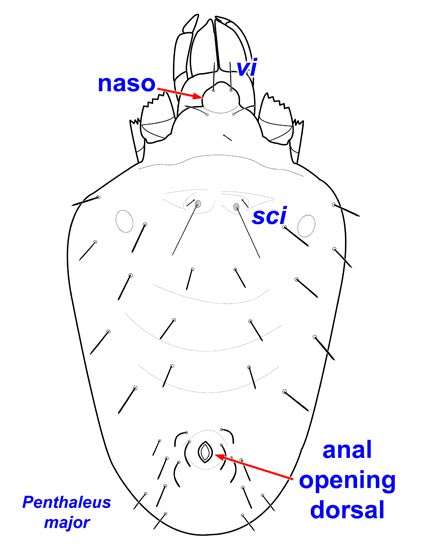Eupodoidea: Penthaleidae
Superorder Acariformes
Order Trombidiformes
Suborder Prostigmata
Supercohort Eupodides
Cohort: Eupodina
Superfamily Eupodoidea
Family Penthaleidae
Common names: red-egged earth mites, black sand mites, pea mites, oat mites, winter grain mites
Probability of Encounter: high
Quarantine importance:
Very high. The red-legged earth mites, winter grain mites and their relatives
are major pests of pasture, lawns, vegetable, and grain crops in many areas of
the world.
Diagnosis:
-
Bodies sac-like with long legs. In life, body dark (black to dark green) and legs red
-
Idiosoma, especially ventrally, and legs hypertrichous
-
Anal opening terminal (Halotydeus), dorso-terminal (Chromotydeus) or dorsal (Penthaleus)
-
Naso present and bearing setae vi; prodorsal setae sci present and trichobothrial (filiform)
-
2 pairs of genital papillae in adult
-
Chelicerae separate, fixed digit regressed, movable digit sickle-like to prong-like
-
Rhagidial organs on tarsi I-II only (Halotydeus, Penthaleus) or on tarsi I-III (Chromotydeus)
Similar taxa.
Ecology & Distribution. Penthaleus major (Dugès) is the best known species in a complex called winter grain, blue oat, or pea mites. They attack a variety of economically important plants including clover, peas, cotton, peanuts, ornamentals, wheat and other grains. These mites are parthenogenetic and males are unknown. In Australia the complex includes P. minor (Canestrini) and P. falcatus Qin & Halliday which can be separated from P. major by differences in setation and cheliceral structure (see Qin & Halliday 1996). Other described species of Penthaleus are known, but not currently considered major pests.
Halotydeus destructor (Tucker), the red-legged earth mite or black sand mite feeds in groups (usually on the upper leaf surface) on vegetable and legume crops, tobacco, and pasture grasses and is a major pest in Australia, New Zealand, and Africa. Other species of Halotydeus include: H. anthroopus Qin & Halliday from clover, grass and cape weed in South Africa; H. bakerae Qin & Halliday from moss, grasses, and saltbush in Australia; H. catrellus Qin & Halliday from undergrowth in forested areas in Australia; H. spectatus Qin & Halliday from grasses in wooded areas in Australia; H. hydrodromus Berlese & Trouessart from littoral and intertidal rocks in France, Italy and Ireland; H. signiensis Strandtmann & Tilbrook from moss in the South Orkney Islands; and H. mollis Luxton from a mangrove beach in Hong Kong.
Chromotydaeus Berlese can be distinguished from other penthaleids by the presence of rhagidial organs on tarsi III. Chromotydeus egregius (Berlese) is known from dry areas in Italy, and C. quartus Qin & Halliday from native shrub and pasture habitats in Australia. Neither are considered pests.
Linopenthaloides novaezealandicus Strandtmann, a mite that lives in caves in New Zealand, is sometimes placed in the Penthaleidae.
References
Baker, A.S. 1996. A redescription of Halotydeus destructor (Tucker) (Prostigmata: Penthaleidae), with a survey of ontogenetic setal development in the superfamily Eupodoidea. Internat. J. Acarol. 21: 261-282.
Qin, T.K. and R.B. Halliday 1996a. Revision of the Australian and South African species of Halotydeus (Acarina: Penthaleidae). Bull. Entomol. Res. 86: 441-450.
Qin, T.K. and R.B. Halliday 1996b. The Australian species of Chromotydaeus Berlese and Penthaleus C.L. Koch (Acarina: Penthaleidae). J. Nat. Hist. 30: 1833-1848.
Ridsdill-Smith, T.J. 1997. Biology and control of Halotydeus destructor (Tucker) (Acarina: Penthaleidae): a review. Experimental and Applied Acarology 21: 195–224.
Ridsdill-Smith TJ, Craig S, Beaton CD. 1996. Microsopic examination of feeding damage to subterranean clover cotyledons caused by Halotydeus destructor (Tucker) (Penthaleidae). pp. 55-57 in R Mitchell, DJ Horn, GR Needham, WC Welbourn (eds). Acarology IX: Volume 1, Proceedings: Ohio Biological Survey, Columbus.
Ridsdill-Smith TJ, Pavri C. 2000. Feeding life style of redlegged earth mite, Halotydeus destructor (Acari: Penthaleidae), in pastures and the role of broad-leafed weeds. Experimental and Applied Acarology 24: 397-414.
Weeks AR, Hoffmann AA. 1999. The biology of Penthaleus species in southeastern Australia. Entomologia Experimentalis et Applicata 92: 179-189.
Weeks AR, Hoffmann AA. 1998. Intense selection of mite clones in a heterogenous environment. Evolution 32: 1325-1333.
Weeks AR, Hoffmann AA 2000. Competitive interactions between two pest species of earth mite, Halotydeus destructor and Penthaleus major (Acarina: Penthaleidae) in pastures and crops. Journal of Economic Entomology 93: 1183-91.
Weeks AR, Turelli M, Hoffmann AA 2000. Dispersal patterns of pest earth mites (Acari: Penthaleidae) in pastures and crops. Journal of Economic Entomology 93: 1415-1423.